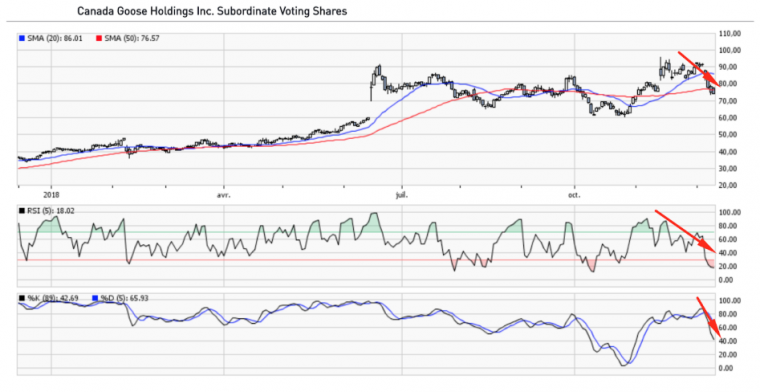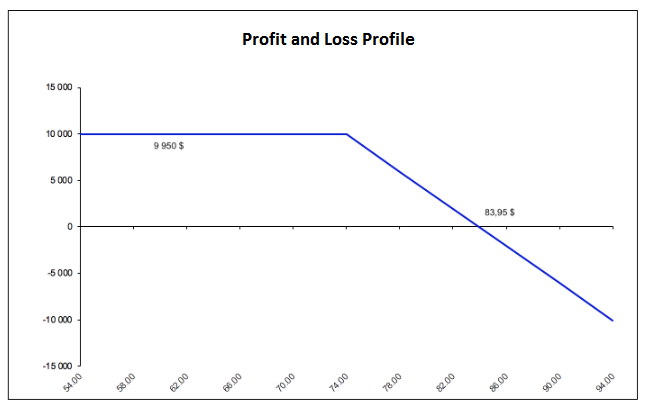Strategy to profit from the tensions with China

Recent events in the news have led us to analyze a stock discussed in our last article. As the following chart shows, the price of shares in Canada Goose Holdings (GOOS) has plummeted by over 20% in the turmoil surrounding the Huawei affair in which, following the arrest of Huawei’s Chief Financial Officer, China called for a boycott of the Canadian firm’s products. Even though the stock could soon rally, the technical damage may result in the $60 support level being tested again.
Daily chart of GOOS ($73.98, Tuesday December 11, 2018)

Normally, an investor who agrees with this scenario and who would like to profit from the situation could buy puts expiring on April 18, 2019, selecting the strike price that would provide the best return if the stock is at $60.00 at expiry. But the implied volatility of options on GOOS has surged in the wake of this fiasco, so we also propose another, much riskier strategy: writing uncovered calls.
Position
Strategy using put options
We will select one of the following puts:
- GOOS 190418 P 84 at $16.40
- GOOS 190418 P 86 at $17.75
- GOOS 190418 P 88 at $19.25
- GOOS 190418 P 90 at $20.75
Comparative Table of Put Options

As the above table demonstrates, out of the four available puts, it is GOOS 190418 P 86 at $17.75 that provides the best combination of risk and return, with a potential return of 46.48% if GOOS is at the target price of $60.00 on April 18, 2019. So we will execute the following transaction:
- Purchase of 10 put options, GOOS 190418 P 86, at $17.75
- $17 750 debit (note that the size of the position needs to be adjusted to suit the amount of capital available for this type of transaction)
Profit and loss profile
Target price for the put options, GOOS 190418 P 86 at $17.75 = $26.00 ($86.00 – $60.00)
Potential profit = $8.25 per share ($26.00 – $17.75), for a total of $8 250
Potential loss = $17.75 per share (the premium paid), or $17 750
Strategy using calls
As mentioned above, the implied volatility of the options is now rather high, with an average reading of 62%, compared to around 40% in September. This means that the options cost much more, so the potential loss is also much higher. This is why a strategy of writing uncovered calls can be used to profit from a drop in the price of GOOS and its relative stability.
This strategy involves writing 10 at-the-money calls, GOOS 190418 C 74 at $9.95, for a total credit of $9 950. We select the at-the-money calls because they are the ones with the most time value.
Profit and loss diagram for writing uncovered calls

This credit also represents the strategy’s maximum profit, which will be realized if GOOS closes at a price equal to or greater than the $74 strike price when the options expire on April 18, 2019. Based on an estimated required margin of $37 000 and using 50% of the strike price as a rule of thumb, the potential return is 26.89% (9 950/37 000). The $83.95 break-even price represents the level above which losses will be incurred if the stock price goes any higher and below which the position will be profitable.
Intervention
In this article, we have presented two strategies aimed at profiting from tensions that may persist and have an adverse effect on the performance of GOOS over the next few weeks. The first strategy (buying optimal puts) may initially appear to be less risky than the second. However, given that the options are highly volatile, the cost incurred to buy the puts increases the position’s risk. The second strategy, which appears riskier, involves selling uncovered calls. This strategy allows us to realize the maximum profit without a large drop in the price of GOOS to the $60 target price. This makes realizing the maximum profit somewhat more likely. However, in contrast to the first strategy, here there is no limit on our maximum loss, so this strategy will need to be very closely monitored. The following paragraphs present the actions required to manage each of these strategies.
Put options
Even though the target price for GOOS shares is $60.00, our potential profit is tied to the $26.00 target price on the puts. This means that as soon as the puts are trading for $26.00, we will liquidate the position, even if GOOS has not attained the target price of $60.00.
Call options
Writing uncovered calls exposes us to losses that are very high or even unlimited. As a result, this position will need to be closely monitored to limit our losses should the price of GOOS rise. So we can consider setting the maximum loss on this position at half of the premium received, i.e. $5 000 or $5.00 per share. Based on this scenario, the position’s stop price will be $88.95 ($83.95 break-even price + $5.00 loss). Should the price rise significantly above this level, we will be forced to close the position to cut our losses.
Good luck with your trading, and have a good week!
The strategies presented in this blog are for information and training purposes only, and should not be interpreted as recommendations to buy or sell any security. As always, you should ensure that you are comfortable with the proposed scenarios and ready to assume all the risks before implementing an option strategy.
President
Monetis Financial Corporation
Martin Noël earned an MBA in Financial Services from UQÀM in 2003. That same year, he was awarded the Fellow of the Institute of Canadian Bankers and a Silver Medal for his remarkable efforts in the Professional Banking Program. Martin began his career in the derivatives field in 1983 as an options market maker for options, on the floor at the Montréal Exchange and for various brokerage firms. He later worked as an options specialist and then went on to become an independent trader. In 1996, Mr. Noël joined the Montréal Exchange as the options market manager, a role that saw him contributing to the development of the Canadian options market. In 2001, he helped found the Montréal Exchange’s Derivatives Institute, where he acted as an educational advisor. Since 2005, Martin has been an instructor at UQÀM, teaching a graduate course on derivatives. Since May 2009, he has dedicated himself full-time to his position as the president of CORPORATION FINANCIÈRE MONÉTIS, a professional trading and financial communications firm. Martin regularly assists with issues related to options at the Montréal Exchange.
The information provided on this website, including financial and economic data, quotes and any analysis or interpretation thereof, is provided solely for information purposes and shall not be construed in any jurisdiction as providing any advice or recommendation with respect to the purchase or sale of any derivative instrument, underlying security or any other financial instrument or as providing legal, accounting, tax, financial or investment advice. Bourse de Montréal Inc. recommends that you consult your own advisors in accordance with your needs before making decision to take into account your particular investment objectives, financial situation and individual needs.
All references on this website to specifications, rules and obligations concerning a product are subject to the rules, policies and procedures of Bourse de Montréal Inc. and its clearinghouse, the Canadian Derivatives Clearing Corporation, which prevail over the content of this website. Although care has been taken in the preparation of the documents published on this website, Bourse de Montréal Inc. and/or its affiliates do not guarantee the accuracy or completeness of the information published on this website and reserve the right to amend or review, at any time and without prior notice, the content of these documents. Neither Bourse de Montréal Inc. nor any of its affiliates, directors, officers, employees or agents shall be liable for any damages, losses or costs incurred as a result of any errors or omissions on this website or of the use of or reliance upon any information appearing on this website.
BAX®, CADC®, CGB®, CGF®, CGZ®, LGB®, MX®, OBX®, OGB®, OIS-MX®, ONX®, SCF®, SXA®, SXB®, SXF®, SXH®, SXM®, SXO®, SXY®, and USX® are registered trademarks of the Bourse. OBW™, OBY™, OBZ™, SXK™, SXJ™, SXU™, SXV™, Montréal Exchange and the Montréal Exchange logo are trademarks of the Bourse. All other trademarks used are the property of their respective owners.
© 2024 Bourse de Montréal Inc. All Rights Reserved.
